Study on the Failure Mechanism for Coal Roadway Stability in Jointed Rock Mass Due to the Excavation Unloading Effect
Abstract
:1. Introduction
2. Engineering Geomechanical Model
2.1. Mine Overview
2.2. Geomechanics Parameters of Roadway Surrounding Rock
3. Deformation Failure Characteristics of Coal Roadway Stability in Gently Inclined Jointed Rock Mass
- (1)
- Influenced by the gradual release of deviator stress to the air due to roadway excavation, the cross-section of roadway surrounding rock continuously shrank. The surrounding rock deformation tended to be stable for more than 70 days. The average deformation rates of roof, floor and side to side within 75 days were 7 mm/d, 9 mm/d and 8 mm/d, respectively.
- (2)
- The deformation distribution was obviously asymmetric, as shown in Figure 6. The convergence of roof to floor of entry was 1.35–2.0 times larger than that of the rib to rib. In addition, the floor heave accounted for 57%–63% of the roof to floor convergence, which was dominant. The heave degree of the right side of the floor was significantly more serious than the left side. The middle and right sides of the roof suffered severe spalling and dilation failures and obvious convexity generated in the right rib.
- (3)
- The support pattern of the transportation adopted the “Bolt-cable-concrete” active support structure, as shown in Figure 7. Thirteen Φ20 mm × 2.2 m rebar bolts were installed in the full cross-section with row spacing of 0.8 m and column spacing of 0.8 m. Four Φ15.24 mm × 7.3m strand bolts were installed in the roof cross-section with a row spacing of 1.6 m and column spacing of 1.2 m. The strength of shotcrete was C20 with a thickness of 100mm. As shown in Figure 6a, shotcrete spalling and cable broken failures frequently occurred in middle and ride side of roof and right rib.
4. Numerical Modeling of Coal Roadway Stability in Gently Inclined Jointed Rock Mass
4.1. Establishment of Numerical Model
4.2. Calibration of Rock Mass Parameters
4.3. Numerical Simulation Scheme
5. Instability Failure Characteristics of Coal Roadway in Slowly Inclined Jointed Rock Mass Due to Excavation Unloading
5.1. Deformation Characteristics
5.2. Macroscopic Fracture Propagation Characters
5.3. Microscopic Fracture Propagation Characters
5.4. Stress Evolution Characters
6. Discussion
- (1)
- The gradual release of deviator stress due to excavation unloading caused the generation, incorporated and propagated of stress concentration zone in roadway surrounding rock. When the stress concentration degree exceeded the bearing strength of the surrounding rock, the stress release zone began to appear in surrounding rock. The stress release degree in the stress release zone increased continuously until the model ran to the equilibrium state. The tension stress began to generate in the stress release zone when the maximum principal stress released completely.
- (2)
- The concentration of the maximum principal stress caused the generation, propagation and incorporation of shear cracks. A number of long coalescent shear cracks formed in the floor and the right side of the roof. The tension stress caused the generation, propagation and incorporation of tension cracks in the entry surrounding rock. A number of long coalescent tension cracks formed in the left side of the floor and the right side of the roof.
- (3)
- The development and propagation of the tension crack caused the generation, propagation and incorporation of macro fractures in surrounding rock, which caused serious fragmentation and dilatation deformation. The asymmetric long coalescent tension cracks caused serious fragmentation and dilation deformation in the left side of the floor and the right side of the roof. Roof caving, floor heave and rib spalling generated in the right side of the roof, the left side of the floor and the right rib, respectively, the simulated failure characteristics is in good agreement with the field investigation.
- (4)
- The bearing strength of the support structure was too low to resist the concentrated stress. The enhancing of the bearing strength of support structure could reduce the stress concentration degree and range, then inhibit the generation and develop of shear cracks, especially the long coalescent shear cracks. The confining pressure applied by the pre-stress on the active support structure was insufficient. The enhancing of confining pressure can significantly increase the residual strength of surrounding rock [34] and greatly reduce the stress release degree and the range, then restrain the generation of tension stress and tension crack. The elongation of active support structure was too small to inhibit the fragmentation and dilatation deformation in surrounding rock. The enhancing of elongation of active support structure can inhibit the slip, open and incorporation of macro fractures in the surrounding rock.
7. Conclusions
- (1)
- The surrounding rock structure scanning results reveal that micro-fractures and a large number of randomly distributed joints can be found in roadway surrounding rock. Under the stress disturbance caused by roadway excavation, micro-fractures extend and incorporate through the joint surface of the rock mass. Fragmentation, dilatation and even instability failures then occurred in the surrounding rock.
- (2)
- The field investigation and monitoring of deformation failure characteristics in surrounding rock indicated that the cross-section of roadway surrounding rock continuously shrank. The deformation distribution was obviously asymmetric. The convergence of the roof to floor of entry was obviously larger than that of the rib to rib. Moreover, the floor heave was dominant in the roof to floor convergence. The heave degree of the left side of the floor was significantly more serious than the right side. The middle and right sides of the roof suffered severe spalling and dilation failures, and obvious convexity generated in the right rib. Support structure failures frequently occurred in middle and ride side of roof and right rib.
- (3)
- The asymmetric large deformation failure mechanism of coal roadway stability in gently inclined jointed rock mass due to excavation unloading has been revealed by the discrete element method combining with field engineering tests. With the increase in the excavation unloading degree, the stress concentration zone generated, incorporated and propagated to the deep surrounding rock. The concentration of the maximum principal stress caused the generation, propagation and incorporation of shear cracks. A number of long coalescent shear cracks formed in the floor and the right side of the roof. When the stress concentration degree exceeded the bearing strength of the surrounding rock, the stress release zone began to appear in shallow surrounding rock and extended continuously to the deep surrounding rock. The stress release degree in the stress release zone increased continuously until the model ran to the equilibrium state. The tension stress began to generate in the stress release zone when the maximum principal stress released completely. The tension stress caused the generation, propagation and incorporation of tension cracks in the roadway surrounding rock. A number of long coalescent tension cracks formed in the left side of the floor and the right side of the roof. The development and propagation of the tension crack caused the generation, propagation and incorporation of macro fractures in surrounding rock, which caused serious asymmetric fragmentation and dilatation deformation. The bearing strength of the support structure was too low to resist the concentrated stress. The confining pressure applied to the support structure was insufficient to restrain the crack propagation. The elongation of the support structure was too small to inhibit the fragmentation and dilatation deformation in surrounding rock. In this paper, the influence of excavation unloading on coal roadway stability in jointed surrounding rock was studied, mainly focusing on stress, crack evolution and deformation failure processes. Further field engineering tests and numerical simulations are needed to study the control effects of high bearing strength, high pre-stress and large elongation reinforcement measures on the serious asymmetric fragmentation and dilatation deformation in the jointed rock mass of a coal roadway due to excavation unloading.
Author Contributions
Funding
Conflicts of Interest
References
- Milici, R.C.; Flores, R.M.; Stricker, G.D. Coal resources, reserves and peak coal production in the United States. Int. J. Coal Geol. 2013, 113, 109–115. [Google Scholar] [CrossRef]
- Yang, X.J.; Wang, E.Y.; Ma, X.G.; Zhang, G.F.; Huang, R.F.; Lou, H.P. A case study on optimization and control techniques for entry stability in Non-Pillar Longwall Mining. Energies 2019, 12, 391. [Google Scholar] [CrossRef] [Green Version]
- Lu, J. Research on Support Technique of Deep Soft Rock Mining Roadway in Qingyun Coal Mine. Master’s Thesis, Taiyuan University of Technology, Taiyuan, China, 2019. [Google Scholar]
- Hu, Z.Q.; Xiao, W.; Wang, P.J.; Zhao, Y.L. Concurrent mining and reclamation for underground coal mining. J. China Coal Soc. 2013, 38, 301–307. [Google Scholar] [CrossRef]
- Kang, H.P. Sixty years development and prospects of rock bolting technology for underground coal mine roadways in China. J. China Min. Technol. 2016, 45, 1071–1081. [Google Scholar] [CrossRef]
- Kang, H.P. Support technologies for deep and complex roadways in underground coal mines: A review. Int. J. Coal Sci. Technol. 2014, 1, 261–277. [Google Scholar] [CrossRef] [Green Version]
- Kang, H.P.; Wu, Z.G.; Gao, F.Q.; Ju, W.J. Effect of geological structures on in-situ stress distribution in underground coal mines. Chin. J. Rock Mech. Eng. 2012, 31, 2674–2680. [Google Scholar] [CrossRef]
- Jing, H.W.; Li, Y.H.; Xu, G.A.; Chen, K.F. Analysis of displacement of broken surrounding rock of deep roadway. J. China Min. Technol. 2006, 35, 565–570. [Google Scholar] [CrossRef]
- Yang, X.X.; Kulatilake, P.H.S.W.; Jing, H.W.; Yang, S.Q. Numerical simulation of a jointed rock block mechanical behavior adjacent to an underground excavation and comparison with physical model test results. Tunn. Undergr. Space Technol. 2015, 50, 129–142. [Google Scholar] [CrossRef]
- Xie, H.P.; Gao, F.; Ju, Y. Research and Development of Rock mechanics in Deep Ground Engineering. Chin. J. Rock Mech. Eng. 2015, 34, 2161–2178. [Google Scholar] [CrossRef]
- Yang, S.Q.; Chen, M.; Jing, H.W.; Chen, K.F.; Meng, B. A case study on large deformation failure mechanism of deep soft rock roadway in Xin’An coal mine, China. Eng Geol. 2017, 217, 89–101. [Google Scholar] [CrossRef]
- Feng, F.; Chen, S.J.; Li, D.Y.; Hu, S.T.; Huang, W.P.; Li, B. Analysis of fractures of a hard rock specimen via unloading of central hole with different sectional shapes. Energy Sci. Eng. 2019, 7, 2265–2286. [Google Scholar] [CrossRef] [Green Version]
- Gao, F.Q.; Stead, D.; Coggan, J. Evaluation of coal longwall caving characteristics using an innovative UDEC Trigon approach. Comput. Geotech. 2014, 55, 448–460. [Google Scholar] [CrossRef] [Green Version]
- Maleki, H.; Stewart, C.; Stone, R.; Abshire, J. Practical Application of Numerical Modeling for the Study of Sudden Floor Heave Failure Mechanisms. In Proceedings of the international workshop on numerical modeling for underground mine excavation design, Pittsburgh, PA, USA, 28 June 2009; pp. 89–100. [Google Scholar]
- Souley, M.; Françoise, H.; Thoraval, A. The effect of joint constitutive laws on the modelling of an underground excavation and comparison with in situ measurements. Int. J. Rock Mech. Min. 1997, 34, 97–115. [Google Scholar] [CrossRef]
- Feng, F.; Li, X.B.; Rostami, J.; Peng, D.X.; Li, D.Y.; Du, K. Numerical investigation of hard rock strength and fracturing under polyaxial compression based on Mogi-Coulomb failure criterion. Int. J. Geomech. 2019, 19, 04019005. [Google Scholar] [CrossRef]
- Alejano, L.R.; Taboada, J.; García-Bastante, F.; Rodriguez, P. Multi-approach back analysis of a roof bed collapse in a mining room excavated in stratified rock. Int. J. Rock Mech. Min. Sci. 2008, 45, 899–913. [Google Scholar] [CrossRef]
- Zang, C.W.; Chen, M.; Zhang, G.C.; Wang, K.; Gu, D.D. Research on the failure process and stability control technology in a deep roadway: Numerical simulation and field test. Energy Sci. Eng. 2020, 00, 1–14. [Google Scholar] [CrossRef] [Green Version]
- Li, X.H.; Ju, M.H.; Yao, Q.L.; Zhou, J.; Chong, Z.H. Numerical investigation of the effect of the location of critical rock block fracture on crack evolution in a gob-side filling wall. Rock Mech. Rock Eng. 2016, 49, 1041–1058. [Google Scholar] [CrossRef]
- Kang, H.P.; Lin, J.; Fan, M.J. Investigation on support pattern of a coal mine roadway within soft rocks—A case study. Int. J. Coal. Geol. 2015, 140, 31–40. [Google Scholar] [CrossRef]
- Wang, P.; Jiang, L.S.; Zheng, P.Q.; Qin, G.P.; Zhang, C. Inducing mode analysis of rock burst in fault-affected zone with a hard-thick stratum occurrence, Environ. Earth Sci. 2019, 78, 467. [Google Scholar] [CrossRef]
- Le, T.D.; Oh, J.; Hebblewhite, B.; Zhang, C.G.; Mitra, R. A discontinuum modelling approach for investigation of Longwall Top Coal Caving mechanisms. Int. J. Rock Mech. Min. 2018, 106, 84–95. [Google Scholar] [CrossRef]
- Zhang, G.F.; Yu, S.B.; Li, G.F.; Huo, J.Y. Research on complementary supporting system of constant resistance with load release for three-soft mining roadway in extremely thick coal seam. Chin. J. Rock Mech. Eng. 2011, 30, 1619–1626. [Google Scholar] [CrossRef]
- Yang, X.J.; Pang, J.W.; Lou, H.P.; Fan, L.P. Characteristics of in situ stress field at Qingshui coal mine. Int. J. Min. Sci. Technol. 2015, 25, 497–501. [Google Scholar] [CrossRef]
- Yin, J.Y. Failure Mechanism and Supporting Measures of Deep Coal Roadway in Shenbei Mining Area. Ph.D. Thesis, China University of Mining and Technology, Beijing, China, 2012. [Google Scholar]
- Wang, E.Y. Modeling of Failure Mechanism and Control Techniques for Entry Stability in Slowly Inclined Jointed Rock Mass Due to Excavation Unloading Effect. Ph.D. Thesis, China University of Mining and Technology, Beijing, China, 2019. [Google Scholar]
- Gao, F.Q.; Stead, D.; Kang, H.P.; Wu, Y.Z. Discrete element modelling of deformation and damage of a roadway driven along an unstable goaf—A case study. Int. J. Coal. Geol. 2014, 127, 100–110. [Google Scholar] [CrossRef]
- Yang, X.J.; Wang, E.Y.; Wang, Y.J.; Gao, Y.B.; Wang, P. A Study of the Large Deformation Mechanism and Control Techniques for Deep Soft Rock Roadways. Sustainability 2018, 10, 1100. [Google Scholar] [CrossRef] [Green Version]
- Itasca Consulting Group, Inc. UDEC User Manual; Itasca Consulting Group, Inc.: Minneapolis, MN, USA, 2008. [Google Scholar]
- Ma, W.Q.; Wang, T.X. Compression failure characteristics and crack propagation of brittle rock under various confining pressures. Chin. J. Rock Mech. Eng. 2018, 37, 898–908. [Google Scholar] [CrossRef]
- Gao, F.Q.; Stead, D. The application of a modified Voronoi logic to brittle fracture modelling at the laboratory and field scale. Int. J. Rock Mech. Min. Sci. 2014, 68, 1–14. [Google Scholar] [CrossRef]
- Cho, N.; Martin, C.D.; Sego, D.C. A clumped particle model for rock. Int. J. Rock Mech. Min. 2007, 44, 997–1010. [Google Scholar] [CrossRef]
- Diederichs, M.; Kaiser, P.; Eberhardt, E. Damage initiation and propagation in hard rock during tunnelling and the influence of near-face stress rotation. Int. J. Rock Mech. Min. Sci. 2004, 41, 785–812. [Google Scholar] [CrossRef]
- Goel, R.K.; Swarup, A.; Sheorey, P.R. Bolt length requirement in underground openings. Int. J. Rock Mech. Min. Sci. 2007, 44, 802–811. [Google Scholar] [CrossRef]

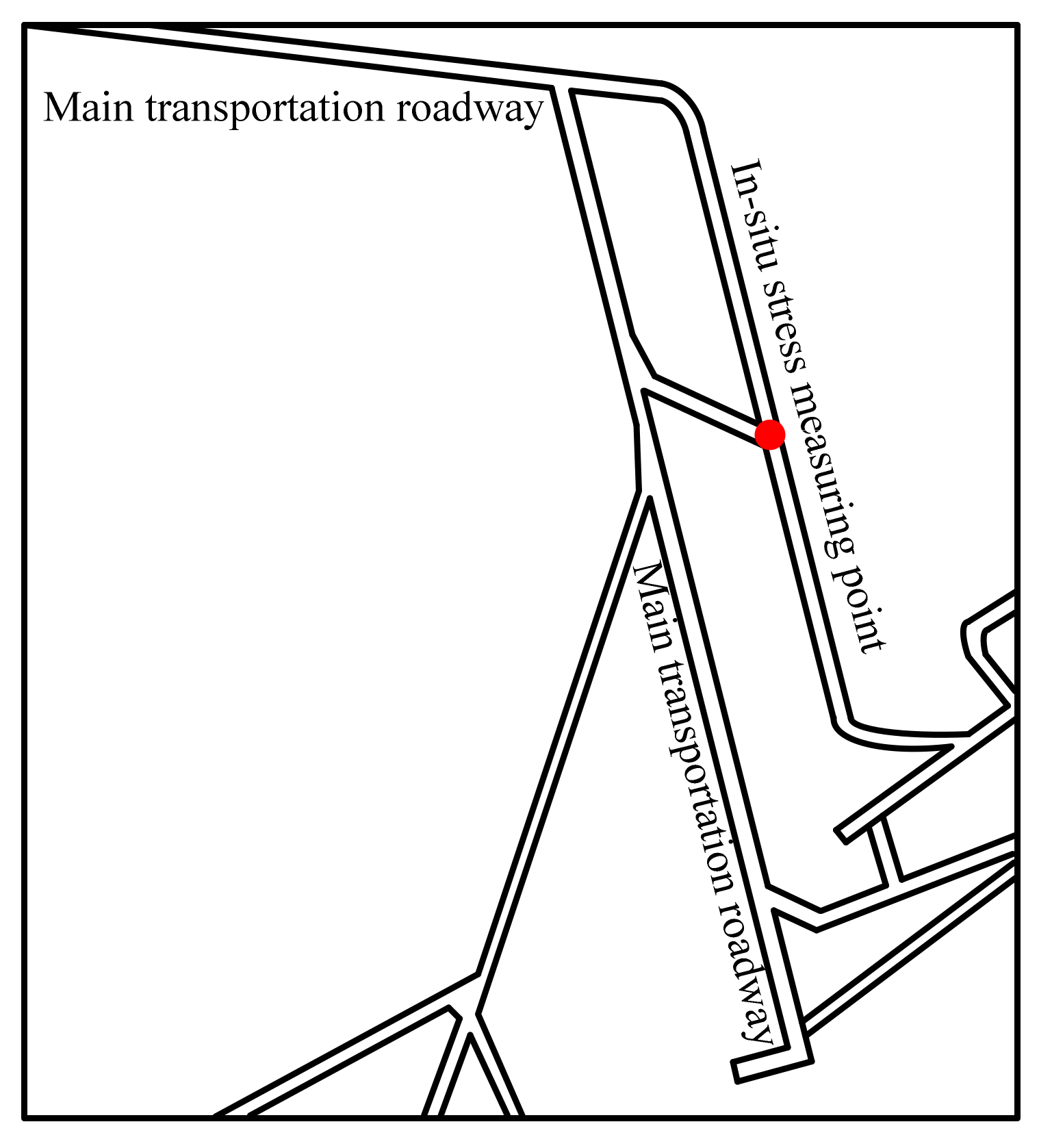
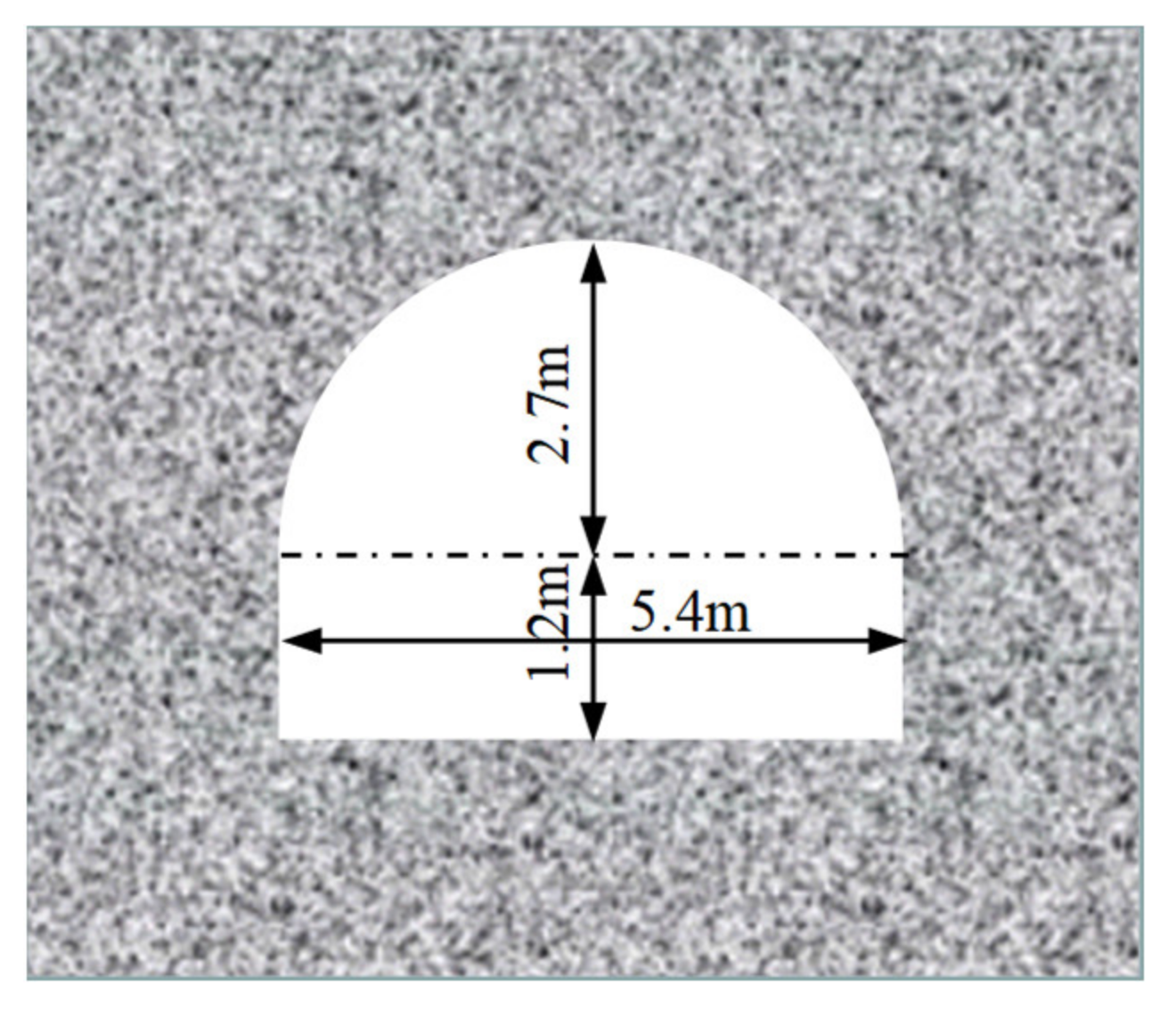
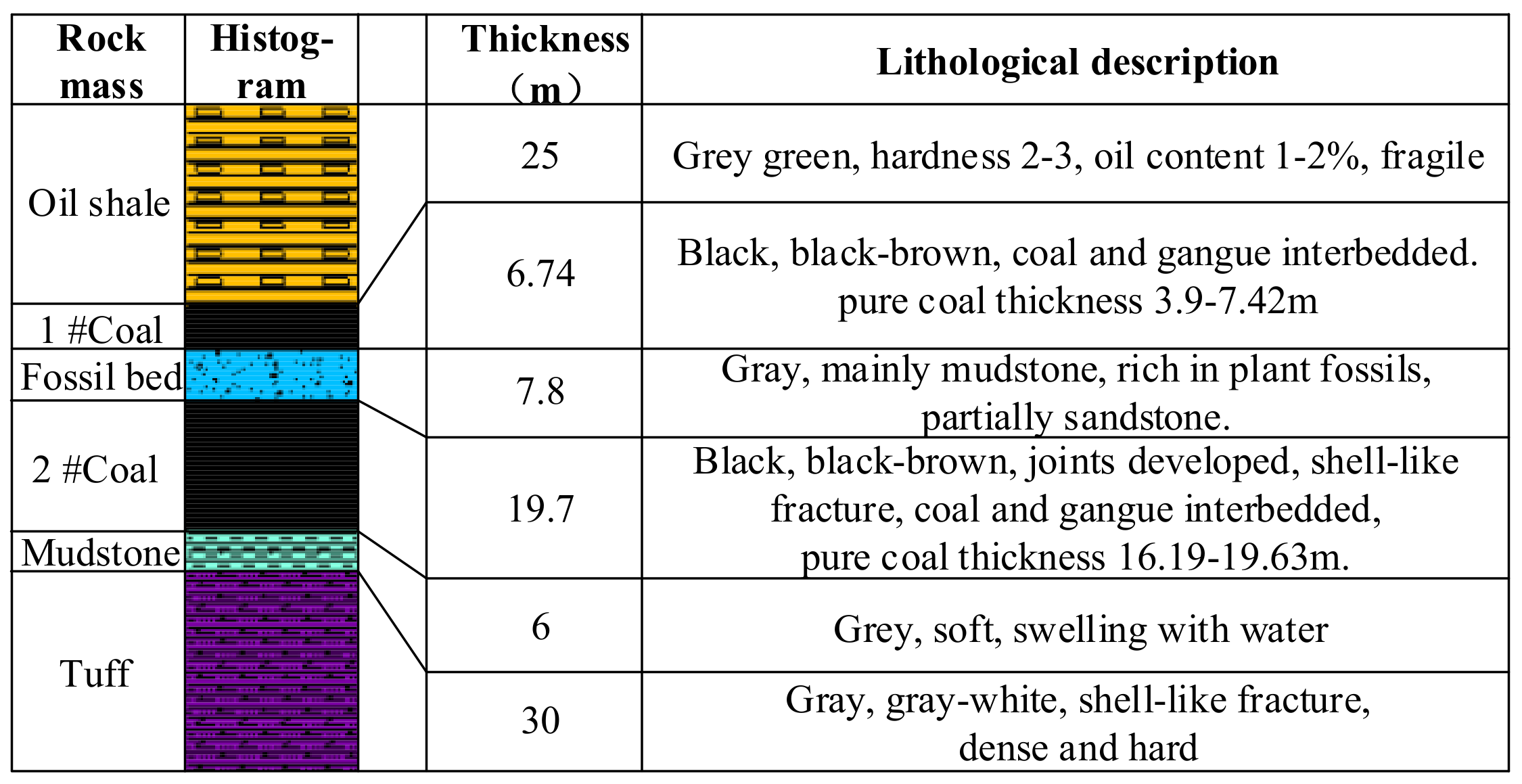


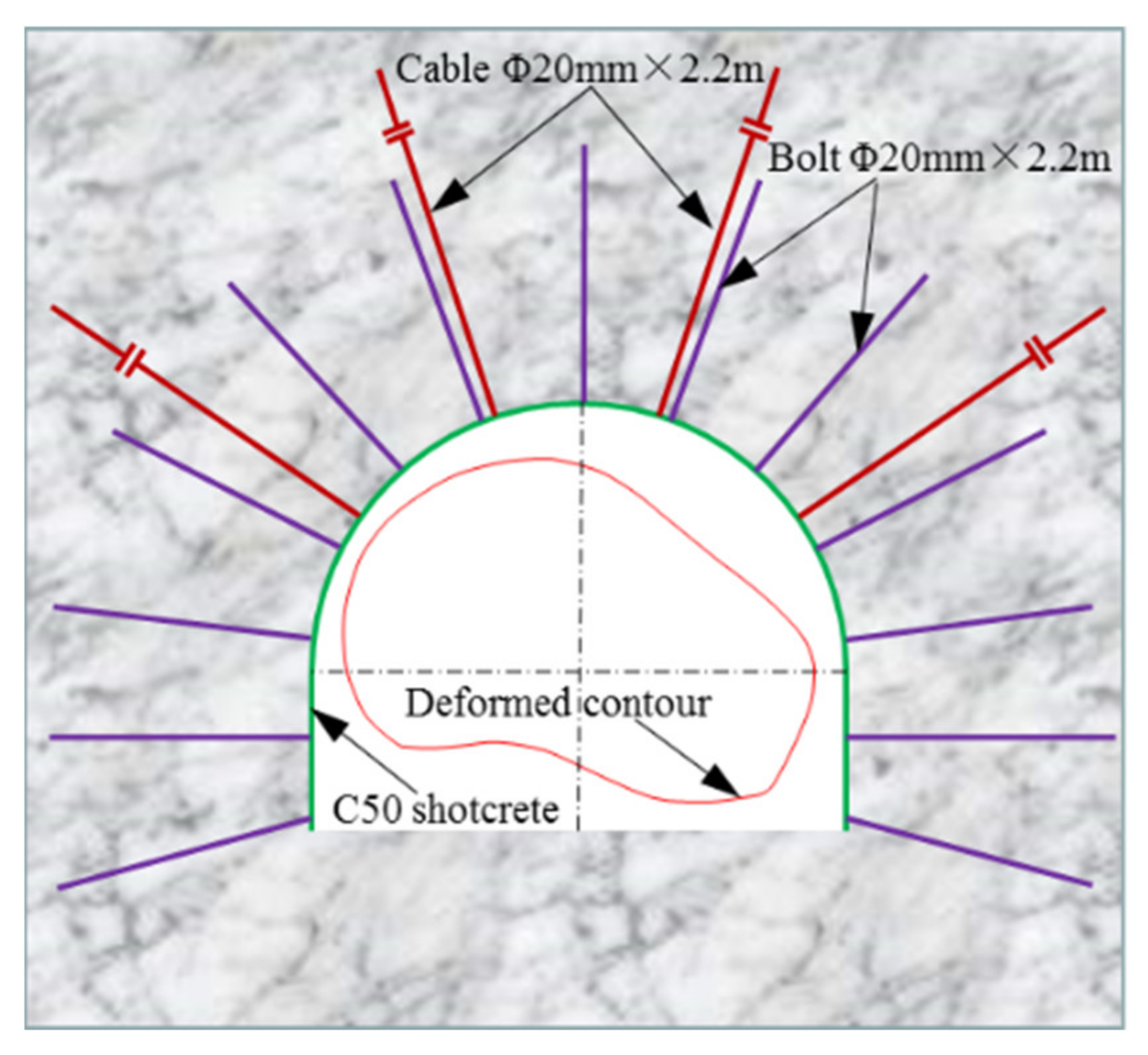
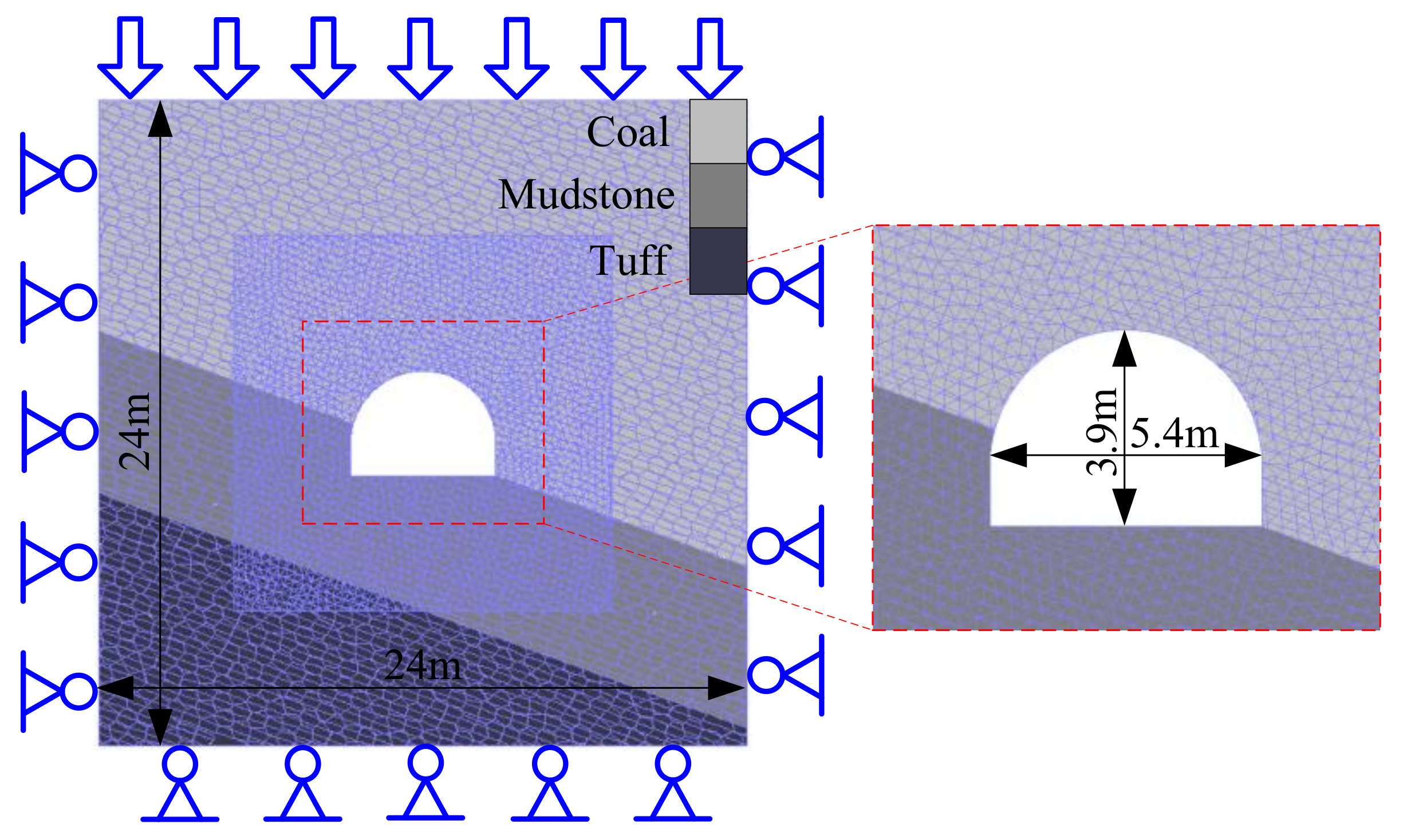
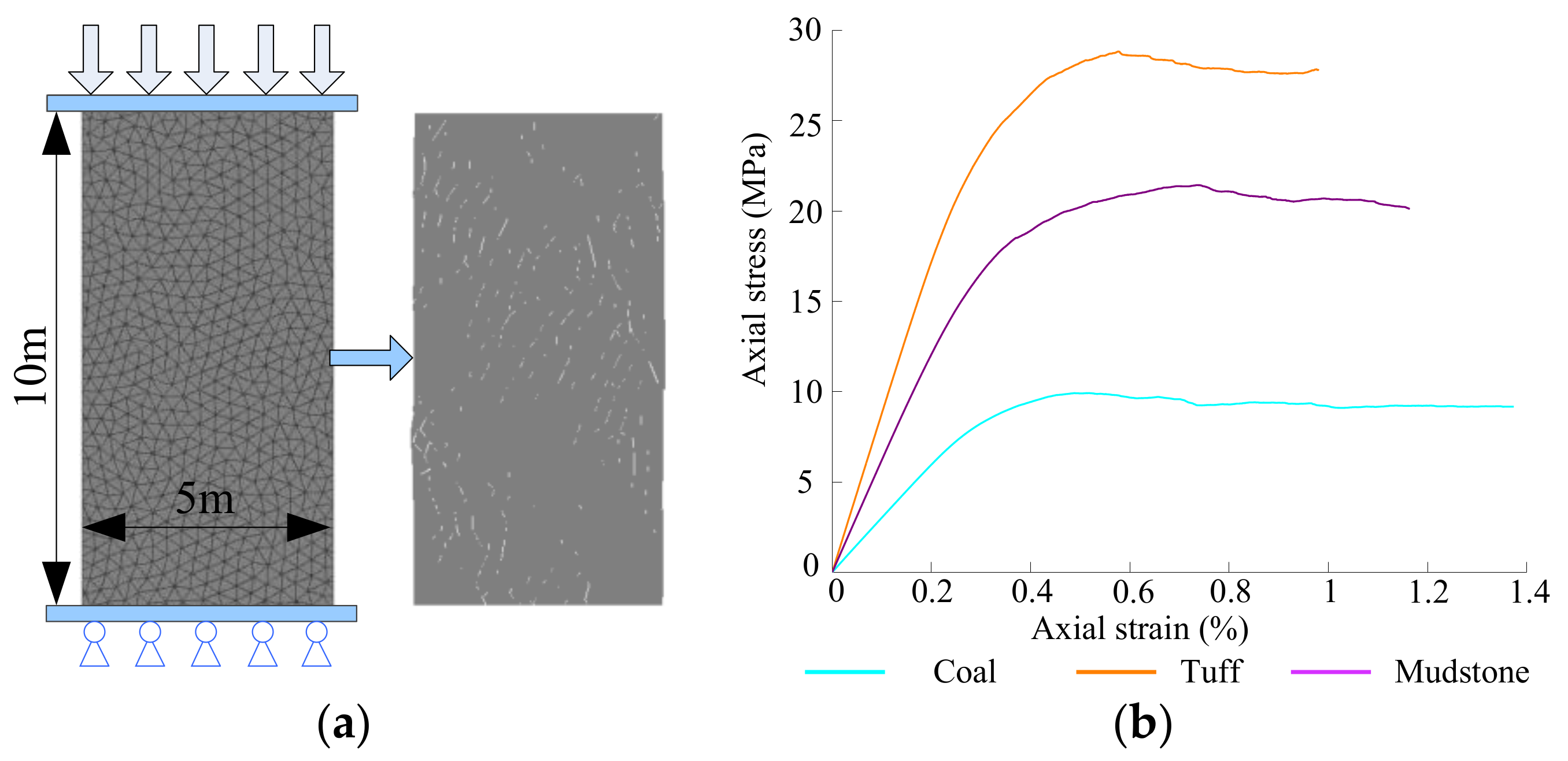



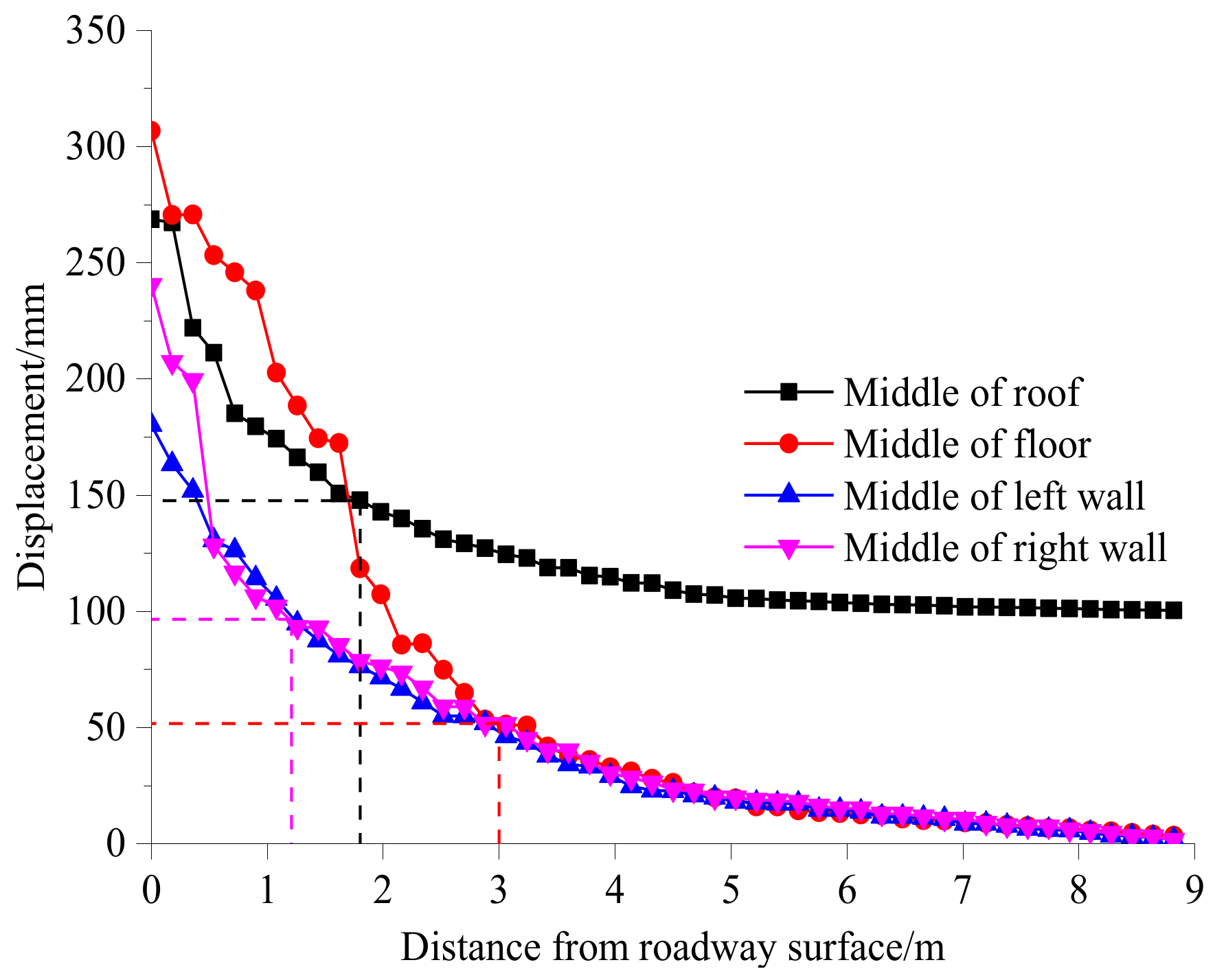
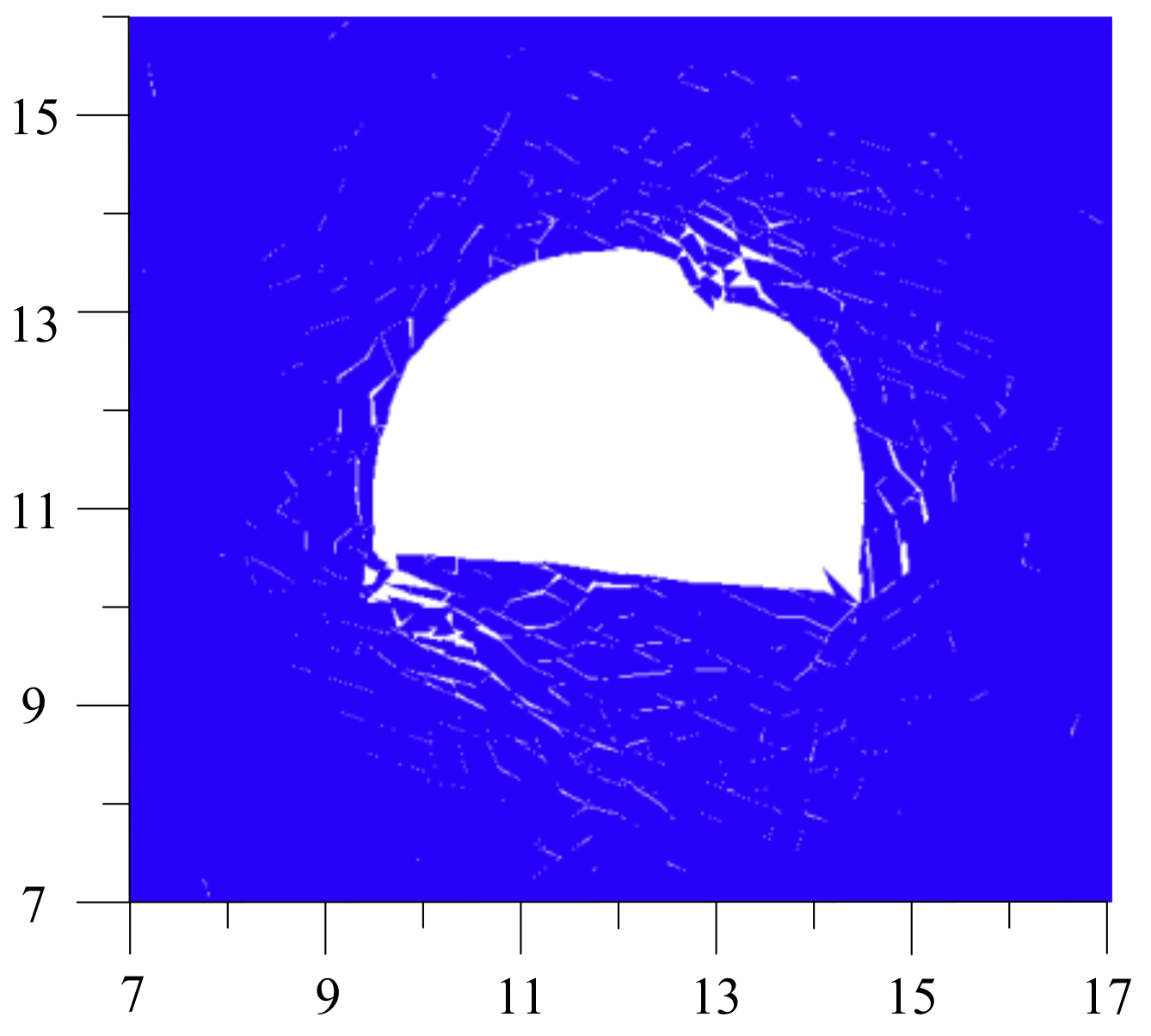
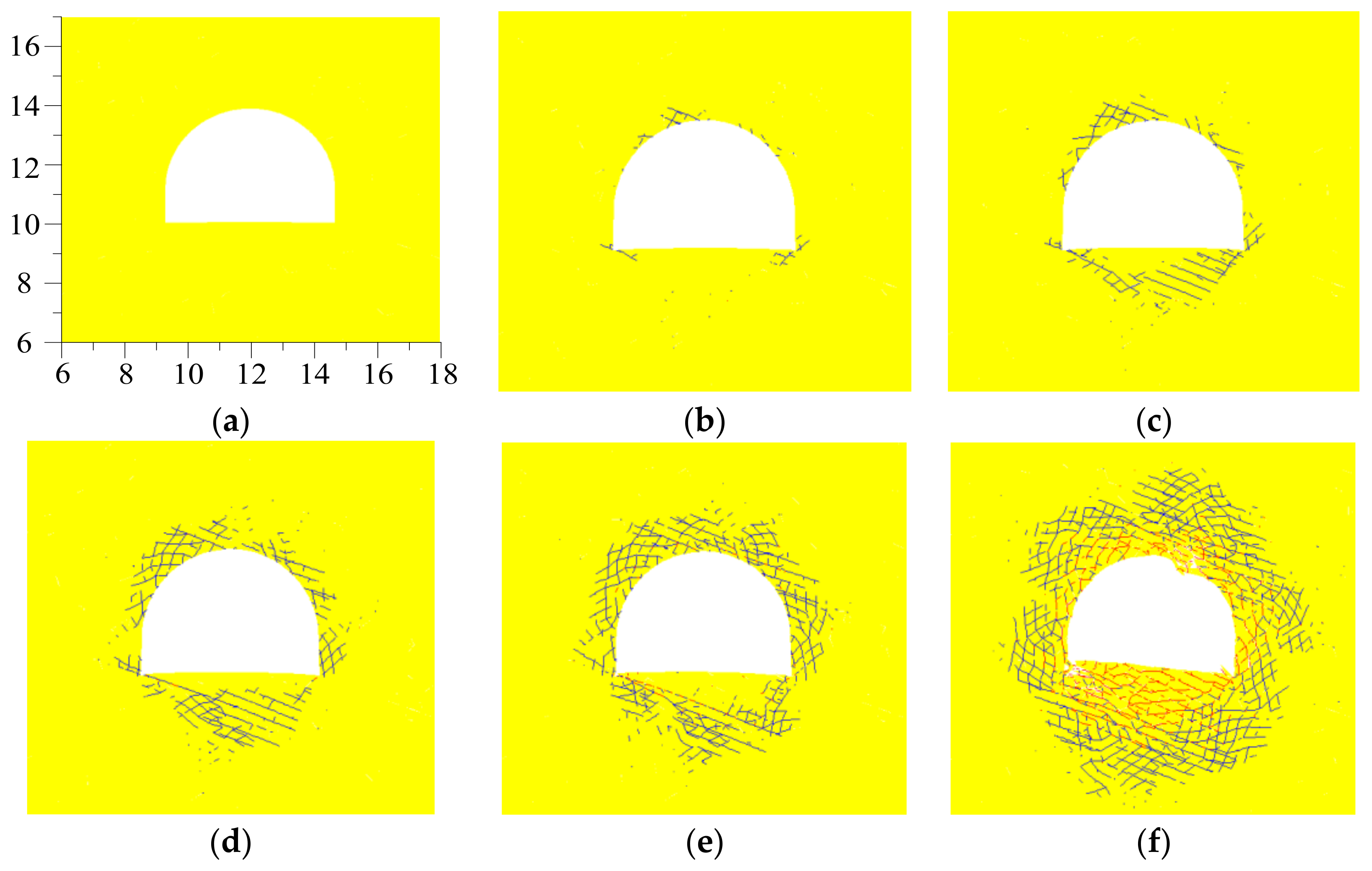
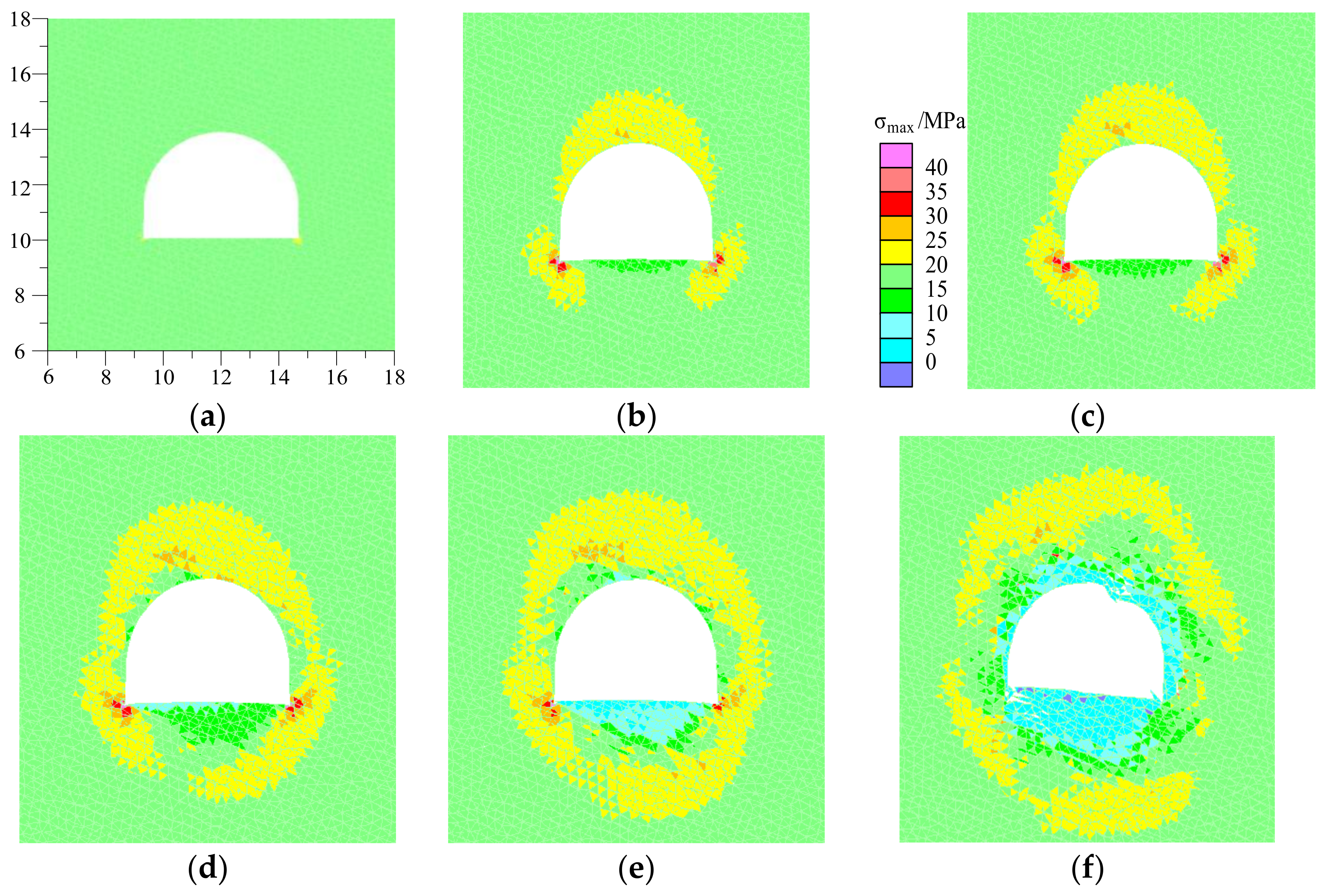
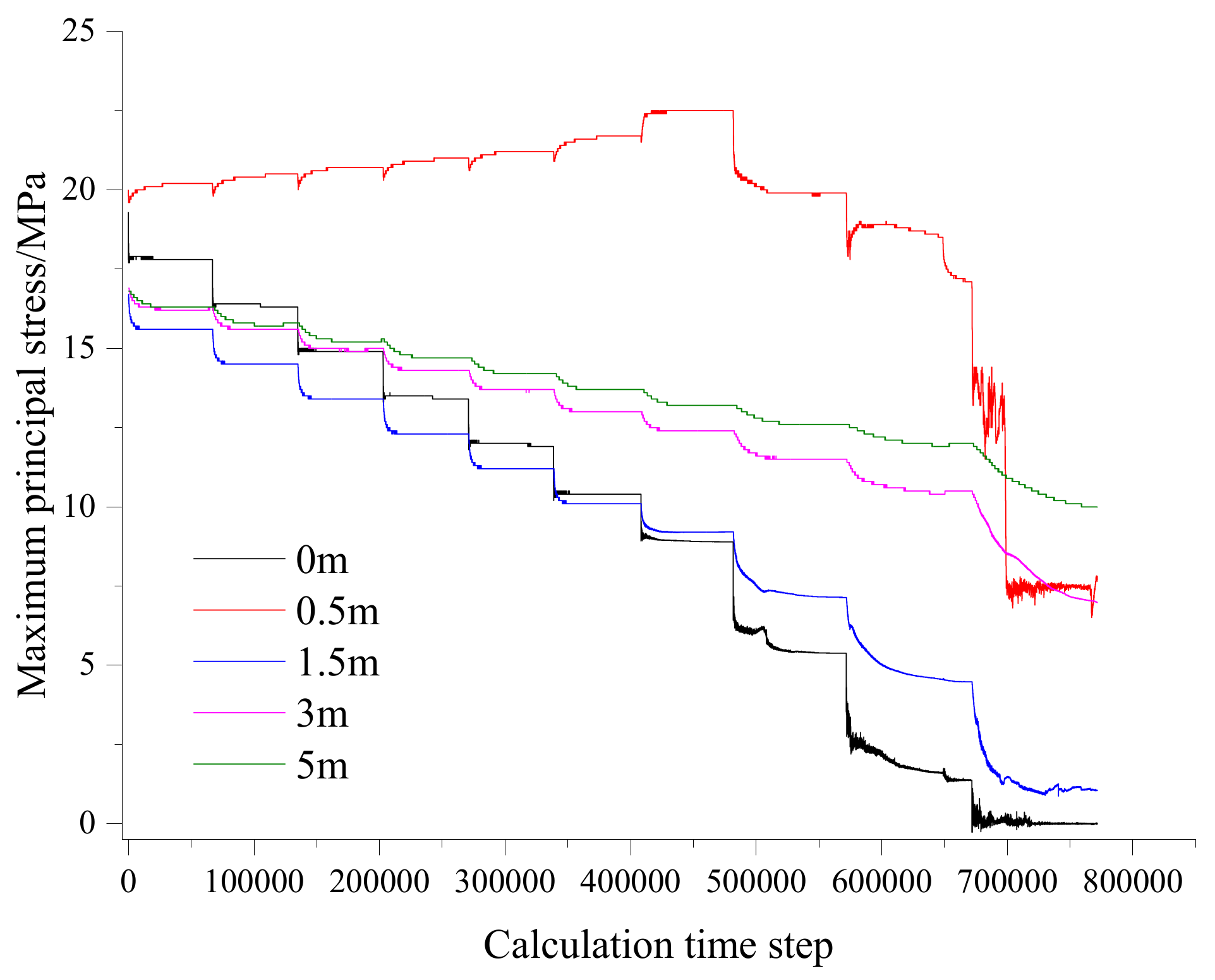
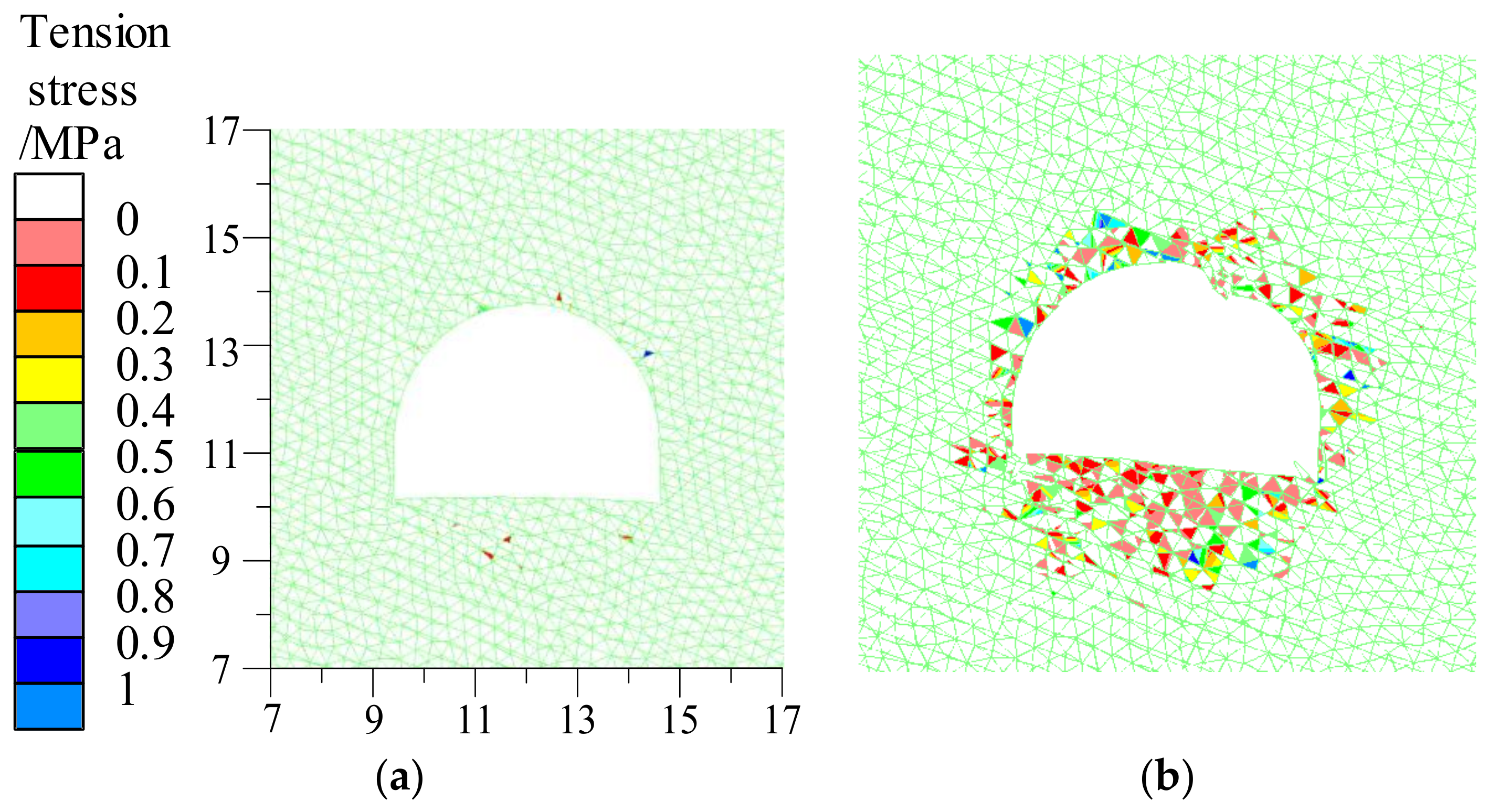
| Measuring Point Location | H/m | σV/MPa | σH/MPa | σh/MPa |
|---|---|---|---|---|
| −450 shaft station | 520 | 14.508 | 17.652 | 8.832 |
| Lithology | Density/(kg/m3) | Compressive Strength/MPa | Tensile Strength/MPa | Elastic Modulus/GPa | Poisson Ratio | Cohesion/MPa | Internal Friction/° |
|---|---|---|---|---|---|---|---|
| Coal | 16.0 | 9.82 | 0.97 | 3.04 | 0.210 | 1.09 | 23 |
| Mudstone | 25.3 | 20.62 | 1.92 | 6.39 | 0.149 | 2.24 | 27 |
| Tuff | 25.6 | 29.21 | 2.77 | 9.06 | 0.135 | 3.26 | 32 |
| Lithology | Block Parameters | Contact Parameters | ||||||
|---|---|---|---|---|---|---|---|---|
| Density /(kg·m−3) | Bulk Modulus /GPa | Shear Modulus /GP | kn /(GPa·m−1) | ks /(GPa·m−1) | Cj /MPa | φj /(°) | σtj /MPa | |
| Coal | 16.0 | 1.75 | 1.26 | 338.14 | 135.26 | 1.71 | 30 | 0.97 |
| Mudstone | 25.3 | 3.03 | 2.78 | 849.46 | 339.78 | 3.04 | 34 | 1.92 |
| Tuff | 25.6 | 4.14 | 3.99 | 1230.58 | 492.23 | 3.35 | 38 | 2.77 |
| Lithology | Elastic Modulus /GPa | Error (%) | Compressive Strength /MPa | Error (%) | ||
|---|---|---|---|---|---|---|
| Target Value | Simulation Value | Target Value | Simulation Value | |||
| Coal | 3.04 | 3.05 | 0.33 | 9.82 | 9.92 | 1.02 |
| Mudstone | 6.39 | 6.25 | 2.19 | 20.62 | 21.44 | 3.98 |
| Tuff | 9.06 | 8.79 | 3.00 | 29.21 | 28.83 | 1.30 |
| Convergence/mm | Middle of Roof | Left Arch Shoulder | Right Arch Shoulder | Middle of Floor | Left Side of Floor | Right Side of Floor | Middle Of Left Rib | Middle Of Right Rib |
|---|---|---|---|---|---|---|---|---|
| Calculated values | 274 | 212 | 311 | 307 | 486 | 143 | 179 | 240 |
| Measured values | 232 | 134 | 308 | 322 | 508 | 153 | 108 | 194 |
© 2020 by the authors. Licensee MDPI, Basel, Switzerland. This article is an open access article distributed under the terms and conditions of the Creative Commons Attribution (CC BY) license (http://creativecommons.org/licenses/by/4.0/).
Share and Cite
Wang, E.; Chen, G.; Yang, X.; Zhang, G.; Guo, W. Study on the Failure Mechanism for Coal Roadway Stability in Jointed Rock Mass Due to the Excavation Unloading Effect. Energies 2020, 13, 2515. https://doi.org/10.3390/en13102515
Wang E, Chen G, Yang X, Zhang G, Guo W. Study on the Failure Mechanism for Coal Roadway Stability in Jointed Rock Mass Due to the Excavation Unloading Effect. Energies. 2020; 13(10):2515. https://doi.org/10.3390/en13102515
Chicago/Turabian StyleWang, Eryu, Guangbo Chen, Xiaojie Yang, Guofeng Zhang, and Wenbin Guo. 2020. "Study on the Failure Mechanism for Coal Roadway Stability in Jointed Rock Mass Due to the Excavation Unloading Effect" Energies 13, no. 10: 2515. https://doi.org/10.3390/en13102515




